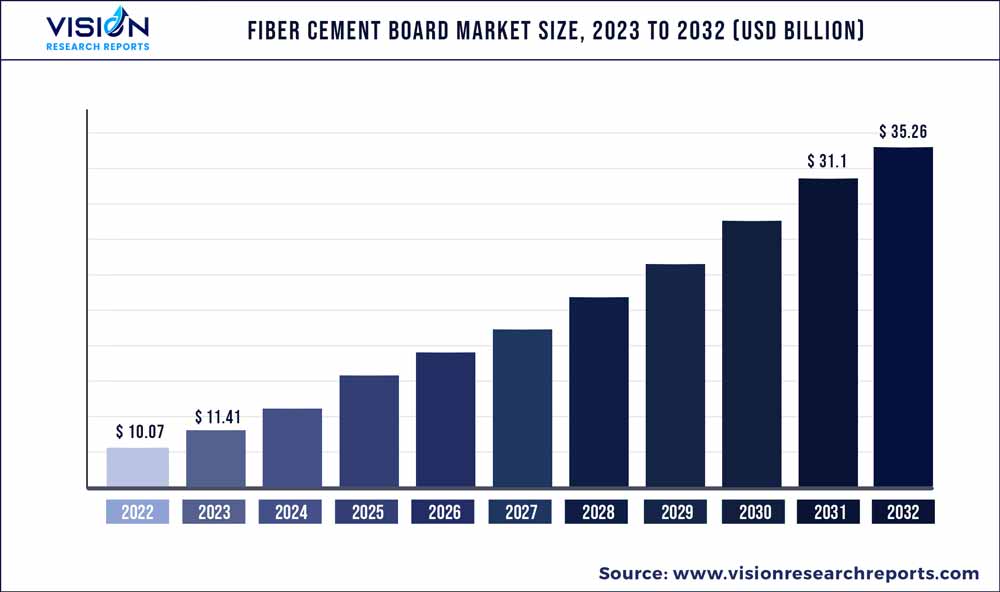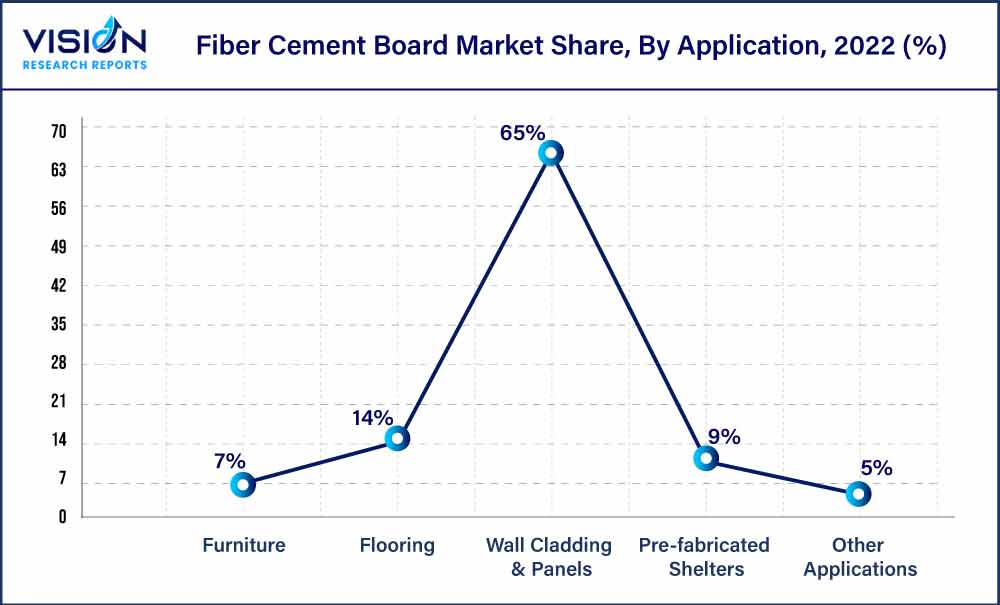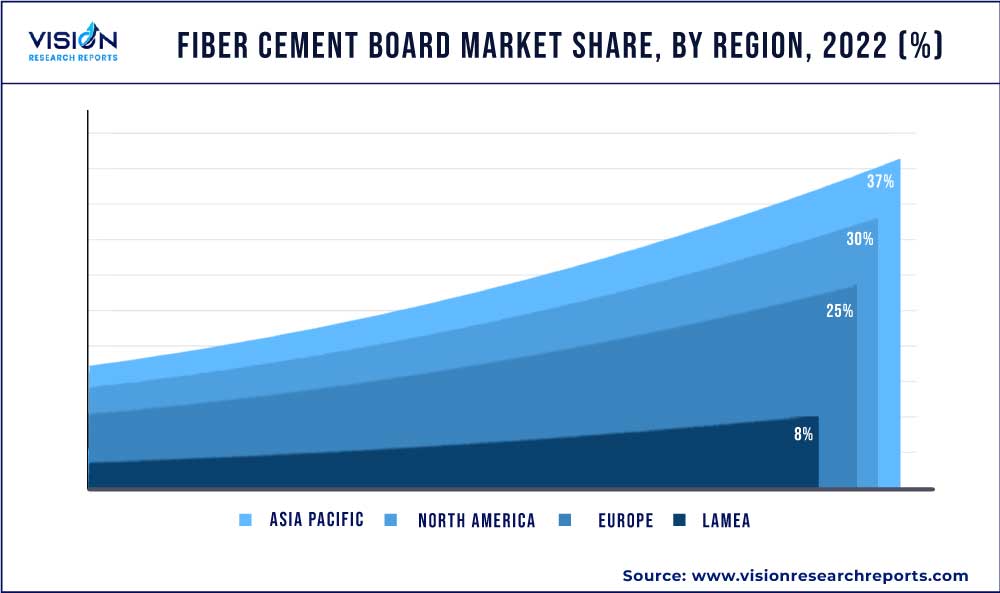The global fiber cement board market was valued at USD 10.07 billion in 2022 and it is predicted to surpass around USD 35.26 billion by 2032 with a CAGR of 13.35% from 2023 to 2032. The fiber cement board market in the United States was accounted for USD 2.6 billion in 2022.

Key Pointers
Report Scope of the Fiber Cement Board Market
| Report Coverage | Details |
| Revenue Share of Asia Pacific in 2022 | 37% |
| CAGR of Middle East & Africa from 2023 to 2032 | 14.13% |
| Revenue Forecast by 2032 | USD 35.26 billion |
| Growth Rate from 2023 to 2032 | CAGR of 13.35% |
| Base Year | 2022 |
| Forecast Period | 2023 to 2032 |
| Market Analysis (Terms Used) | Value (US$ Million/Billion) or (Volume/Units) |
| Companies Covered | Beijing Hocreboard Building Materials Co. Ltd.; HIL Limited; CenturyPly; Everest Industries Limited; SAINT-GOBAIN; Sahyadri Industries Pvt. Ltd.; Toray Building Materials Co., Ltd.; Visaka Industries; James Hardie Building Products Inc.; Allura |
Population expansion in emerging countries, infrastructure upgrades in developed countries, and a tendency toward increased residential and commercial construction are all factors influencing growth. With the growing construction industry, the demand for the paints and coatings segment is also growing. Synthetic fibers are gaining traction and are expected to continue growing due to the increasing use of fiber cement in the production of boards.
Several factors, such as durability, cost-effectiveness, and fire retardancy are driving the product demand in furniture applications. Fiber cement boards have unique features and advantages that make them appealing for furniture use cases. Fiber cement boards can be sculpted and molded into various shapes, and therefore are ideal for furniture production. They are suitable for use as tabletops, shelves, cabinets, and other furniture components.
In the U.S., fiber cement boards are commonly utilized in various building applications such as siding, roofing, flooring, and interior wall cladding. The market for fiber cement boards in the country is likely to grow gradually owing to the rising emphasis on sustainable and energy-efficient construction practices, which is expected to drive the demand for fiber cement boards in the U.S. construction industry. Fiber cement boards are considered eco-friendly materials, resulting in their high demand on account of their advantageous properties such as durability, fire resistance, and low maintenance.
The value chain of the fiber cement board market comprises raw material suppliers, fiber cement board manufacturers/producers, distributors/suppliers, and industrial end users. The raw materials used in the manufacturing of fiber cement boards include cement, acrylic fiber, and other additives, which are derived from crude oil. The global fiber cement board industry comprises numerous raw material suppliers involved in large-scale production of the aforementioned materials.
Most fiber cement board companies have forward and backward integrated into the value chain, enabling them to optimize their operations to manage their operational expenses and establish their market dominance. Votorantim Cimentos, Ciment Quebec Inc., Indorama Corporation, and China National Petroleum Corporation (CNPC) have integrated their operations across the following stages of the value chain, i.e., beginning from raw material supply, product manufacturing, to product distribution/supply to end users.
The manufacturers in the market cater to the needs of the end-users in various ways. A majority of the players in the market distribute their products through distributors, sales offices, and sales representatives spread across different regions. Company-authorized distributors and specialized stores engaged in the sales and distribution of building supplies are major offline channels for fiber cement boards.
Type Insights
The high-density fiber cement board segment dominated the market and accounted for over 61% of the revenue share in 2022 and the segment is expected to continue its dominance over the forecast period. It is a cement-based composite made with cellulose fibers and other components. HDFCB HDFCB (high-density fiber cement board) has various advantages over traditional building materials like wood or gypsum boards; some of them are its superior strength, durability, and resilience to fire, water, and termite damage.
Medium density accounted for USD 2,502.1 Million for the year 2022 owing to its fire resistance, strength, and moisture resistance properties. Medium-density fiber cement board (MDFC) is a type of construction substrate that combines the strength of cement with the flexibility of wood fibers. It is often used in both interior and exterior applications. It is also resistant to warping, rotting, and termite attack, which provides it with a longer lifespan than traditional wood items.
Low density fiber cement (LDFC) board is a form of fiber cement board characterized by its light weight. It is a flexible building material that blends cement, cellulose fibers, and additives to produce a long-lasting and lightweight product. In terms of handling, installation, and performance, LDFC boards have various advantages. They are resistant to impact, weathering, decay, and insect infestation. As a consequence, they are suitable for both internal and external applications, such as flooring, roofing, wall cladding, and decorative displays.
The growing demand for lightweight construction materials is a major driver for LDFC boards. As compared to typical building materials, their low density and light weight make them easier to transport, handle, and install. LDFC boards appeal to builders and architects due to their moisture resistance and longevity.
Application Insights
The wall cladding and panels segment emerged as the largest application segment with over 65% of the market revenue in 2022 owing to its protection against UV radiation and temperature variations. The use of fiber cement boards in wall cladding and panels has been growing owing to increasing urbanization, infrastructural development, and remodeling projects. The application segment can be segmented into furniture, flooring, wall cladding and panels, pre-fabricated shelters, and other applications.

The pre-fabricated shelters is the fastest growing segment with a CAGR of 14.45% in terms of revenue for the year 2022. Fiber cement board panels can be easily made and assembled in a factory setting, enabling faster completion than traditional on-site construction. Due to their ease of construction, pre-fabricated shelters are appealing for a variety of purposes, including crisis aid, temporary housing, and detached construction plants.
Due to their durability, fire resistance, and sustainability, fiber cement boards are growing in acceptance in furniture design and manufacturing. The fiber cement board in furniture applications is still in its early stages, with only a few producers specializing in this material. This provides a chance for futuristic furniture designers and producers to establish themselves in this specialized market.
Fiber cement board is a persistent and adaptable material with many advantages for flooring applications. Additionally, it is gaining popularity due to its resilience and resistance to moisture, pests, and fire as consumers seek long-lasting and low-maintenance flooring solutions. The rise of fiber cement boards in flooring applications is being driven by market demand for such flooring solutions.
Regional Insights
Asia Pacific emerged as the leading regional market and accounted for nearly 37% of the overall revenue share in 2022. The governments in the region are taking efforts to develop infrastructure such as building hospitals, education hubs, commercial centers, and residential complexes. These factors, coupled with the increasing population, are expected to drive the demand for the product in the region.
The North America fiber cement board industry is predicted to grow significantly over the coming years owing to rising demand for environmentally friendly and energy-efficient building materials. Increasing urbanization, renovation and remodeling operations and an emphasis on green building approaches have all contributed to the growth of the market.

Middle East & Africa is expected to be the fastest-growing region with a CAGR of 14.13% in 2022. The construction sector in the Middle East & Africa (MEA) is rapidly growing and is likely to expand in the future, which, in turn, is expected to drive the consumption of fiber cement boards. Along with the construction industry, the region is also expected to grow in terms of furniture which will drive the consumption of fiber cement board in bedding & furniture applications.
The Central & South America market is expected to grow substantially over the forecast period. Changing consumer preferences, low production costs, rapid industrialization, and increasing disposable incomes are anticipated to drive the economic growth of the region over the next few years. These factors are projected to fuel the demand for fiber cement boards in the region over the forecast period.
Fiber Cement Board Market Segmentations:
By Type
By Application
By Regional
Chapter 1. Introduction
1.1. Research Objective
1.2. Scope of the Study
1.3. Definition
Chapter 2. Research Methodology
2.1. Research Approach
2.2. Data Sources
2.3. Assumptions & Limitations
Chapter 3. Executive Summary
3.1. Market Snapshot
Chapter 4. Market Variables and Scope
4.1. Introduction
4.2. Market Classification and Scope
4.3. Industry Value Chain Analysis
4.3.1. Raw Material Procurement Analysis
4.3.2. Sales and Distribution Channel Analysis
4.3.3. Downstream Buyer Analysis
Chapter 5. COVID 19 Impact on Fiber Cement Board Market
5.1. COVID-19 Landscape: Fiber Cement Board Industry Impact
5.2. COVID 19 - Impact Assessment for the Industry
5.3. COVID 19 Impact: Global Major Government Policy
5.4. Market Trends and Opportunities in the COVID-19 Landscape
Chapter 6. Market Dynamics Analysis and Trends
6.1. Market Dynamics
6.1.1. Market Drivers
6.1.2. Market Restraints
6.1.3. Market Opportunities
6.2. Porter’s Five Forces Analysis
6.2.1. Bargaining power of suppliers
6.2.2. Bargaining power of buyers
6.2.3. Threat of substitute
6.2.4. Threat of new entrants
6.2.5. Degree of competition
Chapter 7. Competitive Landscape
7.1.1. Company Market Share/Positioning Analysis
7.1.2. Key Strategies Adopted by Players
7.1.3. Vendor Landscape
7.1.3.1. List of Suppliers
7.1.3.2. List of Buyers
Chapter 8. Global Fiber Cement Board Market, By Type
8.1. Fiber Cement Board Market, By Type, 2023-2032
8.1.1. High-density
8.1.1.1. Market Revenue and Forecast (2020-2032)
8.1.2. Medium-density
8.1.2.1. Market Revenue and Forecast (2020-2032)
8.1.3. Low-density
8.1.3.1. Market Revenue and Forecast (2020-2032)
Chapter 9. Global Fiber Cement Board Market, By Application
9.1. Fiber Cement Board Market, By Application, 2023-2032
9.1.1. Furniture
9.1.1.1. Market Revenue and Forecast (2020-2032)
9.1.2. Flooring
9.1.2.1. Market Revenue and Forecast (2020-2032)
9.1.3. Wall Cladding & Panels
9.1.3.1. Market Revenue and Forecast (2020-2032)
9.1.3. Pre-fabricated Shelters
9.1.3.1. Market Revenue and Forecast (2020-2032)
9.1.3. Other By Applications
9.1.3.1. Market Revenue and Forecast (2020-2032)
Chapter 10. Global Fiber Cement Board Market, Regional Estimates and Trend Forecast
10.1. North America
10.1.1. Market Revenue and Forecast, By Type (2020-2032)
10.1.2. Market Revenue and Forecast, By Application (2020-2032)
10.1.3. U.S.
10.1.3.1. Market Revenue and Forecast, By Type (2020-2032)
10.1.3.2. Market Revenue and Forecast, By Application (2020-2032)
10.1.4. Rest of North America
10.1.4.1. Market Revenue and Forecast, By Type (2020-2032)
10.1.4.2. Market Revenue and Forecast, By Application (2020-2032)
10.2. Europe
10.2.1. Market Revenue and Forecast, By Type (2020-2032)
10.2.2. Market Revenue and Forecast, By Application (2020-2032)
10.2.3. UK
10.2.3.1. Market Revenue and Forecast, By Type (2020-2032)
10.2.3.2. Market Revenue and Forecast, By Application (2020-2032)
10.2.4. Germany
10.2.4.1. Market Revenue and Forecast, By Type (2020-2032)
10.2.4.2. Market Revenue and Forecast, By Application (2020-2032)
10.2.5. France
10.2.5.1. Market Revenue and Forecast, By Type (2020-2032)
10.2.5.2. Market Revenue and Forecast, By Application (2020-2032)
10.2.6. Rest of Europe
10.2.6.1. Market Revenue and Forecast, By Type (2020-2032)
10.2.6.2. Market Revenue and Forecast, By Application (2020-2032)
10.3. APAC
10.3.1. Market Revenue and Forecast, By Type (2020-2032)
10.3.2. Market Revenue and Forecast, By Application (2020-2032)
10.3.3. India
10.3.3.1. Market Revenue and Forecast, By Type (2020-2032)
10.3.3.2. Market Revenue and Forecast, By Application (2020-2032)
10.3.4. China
10.3.4.1. Market Revenue and Forecast, By Type (2020-2032)
10.3.4.2. Market Revenue and Forecast, By Application (2020-2032)
10.3.5. Japan
10.3.5.1. Market Revenue and Forecast, By Type (2020-2032)
10.3.5.2. Market Revenue and Forecast, By Application (2020-2032)
10.3.6. Rest of APAC
10.3.6.1. Market Revenue and Forecast, By Type (2020-2032)
10.3.6.2. Market Revenue and Forecast, By Application (2020-2032)
10.4. MEA
10.4.1. Market Revenue and Forecast, By Type (2020-2032)
10.4.2. Market Revenue and Forecast, By Application (2020-2032)
10.4.3. GCC
10.4.3.1. Market Revenue and Forecast, By Type (2020-2032)
10.4.3.2. Market Revenue and Forecast, By Application (2020-2032)
10.4.4. North Africa
10.4.4.1. Market Revenue and Forecast, By Type (2020-2032)
10.4.4.2. Market Revenue and Forecast, By Application (2020-2032)
10.4.5. South Africa
10.4.5.1. Market Revenue and Forecast, By Type (2020-2032)
10.4.5.2. Market Revenue and Forecast, By Application (2020-2032)
10.4.6. Rest of MEA
10.4.6.1. Market Revenue and Forecast, By Type (2020-2032)
10.4.6.2. Market Revenue and Forecast, By Application (2020-2032)
10.5. Latin America
10.5.1. Market Revenue and Forecast, By Type (2020-2032)
10.5.2. Market Revenue and Forecast, By Application (2020-2032)
10.5.3. Brazil
10.5.3.1. Market Revenue and Forecast, By Type (2020-2032)
10.5.3.2. Market Revenue and Forecast, By Application (2020-2032)
10.5.4. Rest of LATAM
10.5.4.1. Market Revenue and Forecast, By Type (2020-2032)
10.5.4.2. Market Revenue and Forecast, By Application (2020-2032)
Chapter 11. Company Profiles
11.1. Beijing Hocreboard Building Materials Co. Ltd.
11.1.1. Company Overview
11.1.2. Product Offerings
11.1.3. Financial Performance
11.1.4. Recent Initiatives
11.2. HIL Limited
11.2.1. Company Overview
11.2.2. Product Offerings
11.2.3. Financial Performance
11.2.4. Recent Initiatives
11.3. CenturyPly
11.3.1. Company Overview
11.3.2. Product Offerings
11.3.3. Financial Performance
11.3.4. Recent Initiatives
11.4. Everest Industries Limited
11.4.1. Company Overview
11.4.2. Product Offerings
11.4.3. Financial Performance
11.4.4. LTE Scientific
11.5. SAINT-GOBAIN
11.5.1. Company Overview
11.5.2. Product Offerings
11.5.3. Financial Performance
11.5.4. Recent Initiatives
11.6. Sahyadri Industries Pvt. Ltd.
11.6.1. Company Overview
11.6.2. Product Offerings
11.6.3. Financial Performance
11.6.4. Recent Initiatives
11.7. Toray Building Materials Co., Ltd.
11.7.1. Company Overview
11.7.2. Product Offerings
11.7.3. Financial Performance
11.7.4. Recent Initiatives
11.8. Visaka Industries
11.8.1. Company Overview
11.8.2. Product Offerings
11.8.3. Financial Performance
11.8.4. Recent Initiatives
11.9. James Hardie Building Products Inc.
11.9.1. Company Overview
11.9.2. Product Offerings
11.9.3. Financial Performance
11.9.4. Recent Initiatives
11.10. Allura
11.10.1. Company Overview
11.10.2. Product Offerings
11.10.3. Financial Performance
11.10.4. Recent Initiatives
Chapter 12. Research Methodology
12.1. Primary Research
12.2. Secondary Research
12.3. Assumptions
Chapter 13. Appendix
13.1. About Us
13.2. Glossary of Terms
 Cross-segment Market Size and Analysis for
Mentioned Segments
Cross-segment Market Size and Analysis for
Mentioned Segments
 Additional Company Profiles (Upto 5 With No Cost)
Additional Company Profiles (Upto 5 With No Cost)
 Additional Countries (Apart From Mentioned Countries)
Additional Countries (Apart From Mentioned Countries)
 Country/Region-specific Report
Country/Region-specific Report
 Go To Market Strategy
Go To Market Strategy
 Region Specific Market Dynamics
Region Specific Market Dynamics Region Level Market Share
Region Level Market Share Import Export Analysis
Import Export Analysis Production Analysis
Production Analysis Others
Others